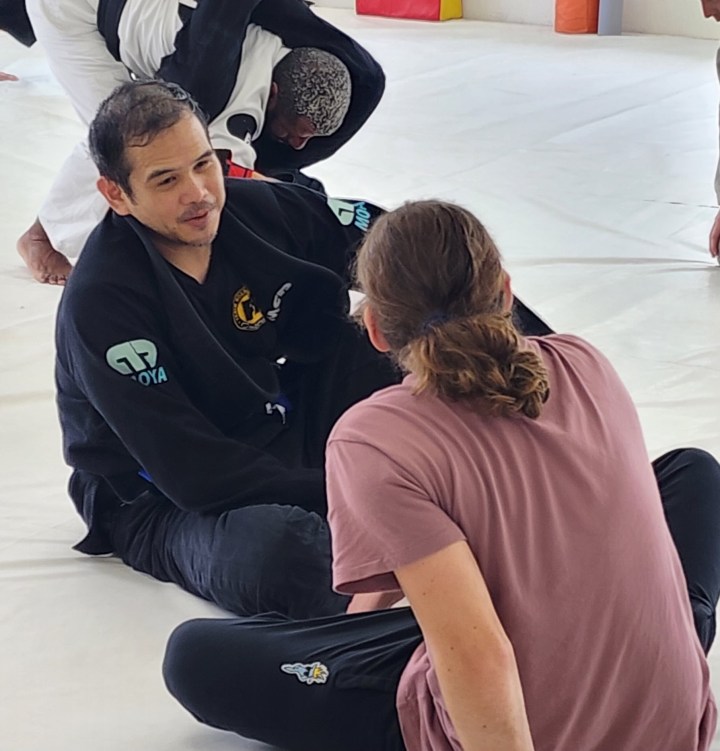
Not too long ago I read a great book called “Transforming Trauma with Jiu-Jitsu” (I will link it at the end of this post). This book validated what I had already started to understand and that is that Jiu-Jitsu can help many people who struggle with various traumas.
This was only verified by the conversations I had on the mats with students who took up Jiu-Jitsu after being sexually assaulted, physically assaulted or were struggling to transition back into civilian life after years in the military.
Post-traumatic stress disorder (PTSD) is a debilitating mental health condition triggered by experiencing or witnessing a terrifying event. Symptoms may include flashbacks, nightmares, severe anxiety, and uncontrollable thoughts about the event. These symptoms are intense, long-lasting, and can significantly interfere with a person’s life. While the path to healing from trauma can be a long and challenging one, Brazilian Jiu Jitsu (BJJ) offers potential benefits that can assist in this journey.
The Neurobiology of PTSD
To understand how Jiu Jitsu can help in trauma recovery, it’s essential to first grasp the basic neurobiology of PTSD. Traumatic experiences can alter brain structure and function, particularly areas like the amygdala, prefrontal cortex, and hippocampus, which are involved in fear responses and memory. This alteration can result in the individual being in a constant state of “fight or flight,” even when there’s no immediate danger.
The Power of the Body in Trauma Recovery
Trauma-focused therapies like Eye Movement Desensitization and Reprocessing (EMDR) and Cognitive Processing Therapy (CPT) are often used in PTSD treatment. However, there’s growing recognition of the role that body-based therapies can play in trauma recovery. This is where Jiu Jitsu enters the picture.
The ‘Roll’ of Jiu Jitsu in Trauma Recovery
Brazilian Jiu Jitsu, with its combination of physical exertion, tactical strategy, and mindfulness, offers a unique approach to trauma recovery. Here’s how:
1. Restoring a Sense of Control
A sense of powerlessness is a common feeling in those with PTSD. Jiu Jitsu, by nature, is about gaining control – control over your body, your movements, and eventually, your opponent. By regularly practicing these maneuvers, an individual can regain a sense of control that extends beyond the mat, helping to counter the feelings of helplessness that trauma often induces.
2. Physical Exertion and Neurochemistry
Physical activity is known to stimulate the production of endorphins, neurotransmitters that act as natural mood elevators. Beyond the ‘feel-good’ factor, regular exercise can promote neurogenesis (creation of new neurons) and neural plasticity (the brain’s ability to reorganize itself by forming new neural connections). This can help counter some of the brain changes induced by trauma.
3. Mindfulness in Motion
Mindfulness, or being completely present in the moment, is a powerful tool for managing PTSD symptoms. Jiu Jitsu, with its requirement for focused attention on the body and its movements, acts as a form of moving mindfulness. This mindful state can provide temporary respite from intrusive thoughts and flashbacks.
4. Creating a Safe Space
Safety – physical, emotional, and psychological – is often compromised in individuals with PTSD. The respectful, disciplined environment of a Jiu Jitsu dojo can provide a sense of safety. Moreover, as the individual becomes more proficient in their skills, they develop a realistic sense of their physical capabilities, further enhancing feelings of safety and security.
5. The Power of a Supportive Community
Human connection and a supportive community are vital components of trauma recovery. A Jiu Jitsu dojo offers a supportive network of individuals working towards common goals. This camaraderie can help mitigate feelings of isolation that often accompany PTSD.
Jiu Jitsu: A Tool, Not a Cure
While the benefits of Jiu Jitsu for trauma survivors are promising, it’s important to remember that it isn’t a stand-alone treatment for PTSD. It should be used as a complementary approach, alongside traditional therapeutic interventions.
Moreover, the practice of Jiu Jitsu should be trauma-informed, meaning the instructors should be aware of the potential triggers and issues that trauma survivors might face. There should be a strong emphasis on consent, respect, and ensuring a safe training environment.
Brazilian Jiu Jitsu, with its unique combination of physical, cognitive, and social elements, offers a compelling approach to body-based trauma recovery. But it’s more than just a recovery tool; it’s a journey towards self-improvement, self-awareness, and perhaps, healing. In the end, it’s not just about the techniques you learn, but the person you become in the process. As Carlos Gracie Sr., one of the founders of Brazilian Jiu Jitsu, once said, “We cannot control the wind, but we can direct the sail.” With its potential benefits for trauma recovery, Jiu Jitsu might just help those grappling with PTSD direct their sails towards calmer waters.